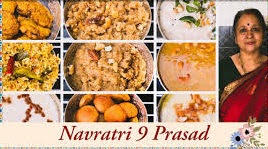In the celebration of Navratri, devotees offer different types of food to Maa Durga over nine days, each day associated with one of her nine forms. Each form is believed to bless devotees with specific qualities and powers. Here's a breakdown of the nine days and the corresponding food offerings:

1. Day 1: Shailputri – Sabudana Khichdi
- Goddess Shailputri is worshipped on the first day. She is the embodiment of the collective power of Brahma, Vishnu, and Shiva.
- Offering: Sabudana Khichdi, a light and sattvic dish, is offered to Shailputri. Sabudana, or tapioca pearls, is easy to digest and a staple for those fasting during Navratri.
2. Day 2: Brahmacharini – Fruits and Panchamrit
- Goddess Brahmacharini is honored on the second day. She represents devotion and penance.
- Offering: Fresh fruits and Panchamrit (a mixture of milk, curd, honey, ghee, and sugar) are offered to her. This represents simplicity and purity, symbolizing her ascetic lifestyle.
3. Day 3: Chandraghanta – Kheer
- Goddess Chandraghanta is the third form of Durga and represents bravery and courage.
- Offering: Kheer, a sweet rice pudding made with milk, rice, and sugar, is a popular offering on this day. The sweetness of kheer symbolizes the sweetness of blessings and strength she bestows upon her devotees.
4. Day 4: Kushmanda – Malpua
- Goddess Kushmanda is worshipped on the fourth day. She is believed to have created the universe with her divine smile.
- Offering: Malpua, a sweet pancake-like dessert made from wheat flour, milk, and sugar, is offered to her. This rich dish symbolizes the nourishment and vitality that Kushmanda brings into the universe.
5. Day 5: Skandamata – Banana
- Goddess Skandamata, the mother of Lord Skanda (Kartikeya), is worshipped on the fifth day. She represents maternal love and the protector of children.
- Offering: Bananas, a fruit symbolizing health and prosperity, are offered to her. It reflects the nurturing aspect of Skandamata and her blessings for the well-being of the family.
6. Day 6: Katyayani – Honey
- Goddess Katyayani is the sixth form, known for her warrior aspect. She is invoked for courage and strength.
- Offering: Honey, a natural sweetener, is offered to Katyayani. Honey represents nature's purity and sweetness, and offering it symbolizes the sweet rewards of courage and bravery.
7. Day 7: Kaalratri – Jaggery and Sweets
- Goddess Kaalratri is fierce and represents the destruction of ignorance and evil.
- Offering: Jaggery and other sweets are offered on this day to calm the fierce form of Kaalratri and seek her blessings for protection and strength in overcoming obstacles.
8. Day 8: Mahagauri – Coconut
- Goddess Mahagauri is the symbol of purity and serenity.
- Offering: Coconut, known for its purity, is offered to Mahagauri. The inner white flesh of the coconut represents purity of thought and intention, while the hard outer shell symbolizes resilience and strength.
9. Day 9: Siddhidatri – Til (Sesame Seeds)
- Goddess Siddhidatri grants knowledge and wisdom to her devotees and is worshipped on the final day of Navratri.
- Offering: Sesame seeds are offered to Siddhidatri. Sesame symbolizes immortality and is believed to ward off negative energies. Offering this promotes spiritual enlightenment and wisdom.
Each of these offerings not only honors a specific aspect of Maa Durga but also aligns with the principles of purity, devotion, and nourishment during the festival.
